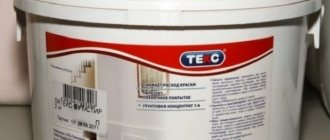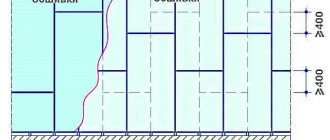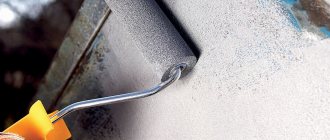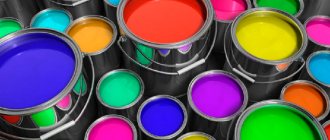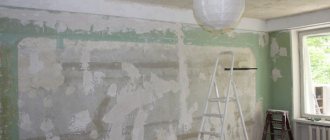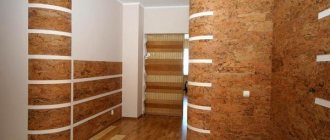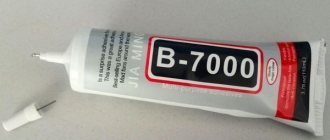Priming of walls and floors is carried out during construction to ensure reliable adhesion of finishing materials to the wall surface. When choosing a primer, you need to pay attention to its technical characteristics and composition. The type of surface, humidity in the room, and further finishing method are taken into account.
Knauf's product range includes mixtures to suit any need. The deep penetration primer Tiefengrund Knauf is popular. It strengthens the surface of the base, reduces its ability to absorb, and improves the adhesion of the finish. Due to its increased penetration ability, it is suitable for materials with small pores.
About Knauf primer
Tiefengrund Knauf is a universal primer that is suitable for both external and internal work. It dries quickly, has no color or specific odor. Provides deep penetration into the surface, completely safe for others. Penetrating primer does not contain plasticizers or solvents. The composition contains fine particles of artificial resins that are resistant to saponification.
The primer is applied in an even layer to the surface, ensuring after drying good adhesion to paint, glue and other finishing materials, which reduces their overall consumption, and therefore saves money on the purchase of building materials. After treating the surface, a protective layer is formed on it, preventing the development of mold, mildew, and corrosion, minor construction flaws, cracks and chips are hidden, the surface continues to breathe and allow water vapor to pass through.
Knauf primer is used for pre-treatment and strengthening of surfaces, including brick, concrete, plaster, etc.
The primer must be used within a year from the date of its manufacture. The container with the composition must be stored closed at an ambient temperature above zero. Freezing of the soil is prohibited.
Primer application technology
Before treating with a primer, the surface must be cleaned of dirt, dust, loose previous coating, and dried thoroughly. Work must be carried out at positive temperatures wearing rubber gloves and safety glasses. The material is non-toxic and allows you to work with it in poorly ventilated areas. The primer must be carefully mixed and applied with a roller or brush onto the surface. Substrates with high hygroscopicity and high porosity, as well as cellular concrete, must be coated 2 times. The primer is easy to apply, spreads well and forms a uniform layer on its own. Substrates with high hygroscopicity and high porosity, as well as cellular concrete, must be coated 2 times. Further finishing work must be carried out after the primer layer has completely dried. Work must be carried out immediately after the primer has dried to avoid dust settling on the surface. Primer drying time is 2 hours.
Areas of application for Tiefengrund Knauf primer
The use of a strengthening mixture improves the adhesion of the finish to the following surfaces:
- plasterboard and gypsum fiber sheets;
- plaster made of gypsum and cement;
- tongue-and-groove gypsum slabs;
- screed made of gypsum and cement.
A penetrating primer is applied before painting walls, laying floor or wall tiles, tiles, before puttingtying and wallpapering. It is used for interior and exterior work, when finishing facades.
Area of use, consumption
The primer can be applied to ceilings, walls and floors before finishing work. Its main purpose is to increase the adhesion rate, that is, the adhesion of the finishing to the surface, as well as to reduce the consumption of paint or other finishing material. Tiefengrund is used before painting walls, laying floor or wall tiles, tiles, before puttying and wallpapering.
It is allowed to use these Knauf products for application on gypsum plaster, which quickly absorbs moisture, as well as gypsum boards, which can be combined with self-leveling floors. A primer composition is used for those surfaces that tend to collapse on their own; on them the mixture creates a strong layer that holds together the smallest particles of the base without interfering with air exchange. The primer composition can be used for both external and internal finishing work.
On average, when applied in one layer, the consumption of Tiefengrund Knauf primer per 1 m2 is 70-100 grams. Products are produced in buckets of 5 and 10 liters.
Advantages
Advantages of Tiefengrund Knauf primer.
- It is not dangerous and does not release toxic substances into the environment.
- It is colorless and odorless.
- The primer contains no solvents.
- A 10-liter bucket is enough to treat 100 m2 of various surfaces.
- Designed for weak foundations, strengthening and protecting them from self-destruction.
- Not afraid of changes in temperature and humidity in the environment.
- The country of origin is Germany, there is a certificate of conformity with GOST. Production quality control is ensured at every stage by the company itself and independent experts.
- Dries quickly.
- Increases the adhesion of surfaces, increases their density and strength.
- Provides complete air exchange and vapor permeability.
- Reduces finishing consumption.
The advantages of choosing Knauf Tiefengrund are demonstrated by technical parameters.
Example "Knauf-Tiefengrund": description, advantages, price
Without thinning, apply a roller, brush or brush to the entire surface of the substrate. Highly hygroscopic surfaces should be filled twice if necessary. Subsequent procedures on the coated surface should only be carried out after drying (approximately 3 hours).
Among the factors influencing the choice of primer, the decisive ones are the humidity of the room, the nature of the base, and the type of decoration. Compositions for any conditions are offered by the manufacturer Knauf. One of the popular mixtures is Tiefengrund Knauf primer. The product has a high-quality certificate of conformity and low consumption. Below are the characteristics, technical parameters and standard material consumption.
Primer from Knauf Tiefengrund series
The primer involves treating the top layer of walls (ceiling/floor) in order to increase the adhesion of materials. With the help of a primer, they create an even layer on which paint, glue, etc. lie evenly. At the same time, the consumption of the same paint will decrease, that is, the primer saves building materials and improves the final result.
Thanks to the penetration of the product deep into the pores, a protective, durable layer is created that prevents the formation of corrosion, mold and mildew. By tightly hiding small cracks and defects, Knauf primer mixture promotes a smoother finish. But despite the density of the primer layer, the surface “breathes”.
Properties of Tiefengrund
This mixture does not have a specific odor - a clear advantage for the application procedure. It does not emit harmful substances into the air, which makes it harmless to the human body. Tiefengrund mixture is used for a wide range of surfaces: plaster, brick, concrete, etc.
Technical characteristics of Tiefengrund
| Characteristic | Meaning |
| Consumption per 1m2 | 0.1 kg |
| Drying time | 3 hours |
| Colors | white, matte |
| Frost resistance | 5 cycles |
| Package | hermetically sealed bucket without film sealing |
| Packing | 5 and 10 kilograms |
| Shelf life in undamaged containers | 12 months |
| Depth of penetration into the base | ≈ 10 cm |
| Degree of penetration into porous materials | deep |
| Smell | absent |
| Can be diluted with water | proportion 1:1 |
The final primer consumption per 1 m2 depends on the type of surface, tool and number of layers applied.
Features of application and consumption of Knauf Tiefengrund primer
Buying a Knauf Tiefengrund primer is half the battle, the main thing is to apply it correctly. First, prepare the surface - the wall. It is cleaned of dirt, old wallpaper (if there is any), stains, and then degreased. If it was previously treated with lime or some kind of peeling coating, then it must be completely cleaned off.
When the wall is ready, you can prime it. They use different tools for this, brushes, a roller, an air spray - whichever is more convenient for you. If the wall is loose and contains a lot of sand or other loose rocks, it is necessary to carry out the application according to the “wet on wet” principle. That is, the first layer of primer is applied, and then, immediately, until the wall is dry, the second layer is applied.
Thin, single layers are applied. If applied too generously, the mixture will literally run off, forming rough smudges. Sometimes additional dilution with water is required. In this case, you can add liquids up to 50%, no more! If the application is successful, then after drying, a thin but durable transparent film forms on the wall.
- Average consumption of Knauf Tiefengrund primer is 0.07-0.1 kg/m2;
- Total drying time is 3 hours.
Certificate of conformity
The manufacturing company Knauf has a certificate of product compliance with high European quality standards. The document indicates that the soil was subjected to all necessary research and control, which ultimately confirmed the product’s compliance with GOST.
Certification of the composition consisted of:
- selection of material for laboratory research;
- analysis of production and technological manufacturing processes;
- certification based on indicators.
After all control studies, the composition is labeled and certified.
Product Certification
The quality certificate received by the company for the Tiefengrund primer indicates that control measures and research have been carried out.
Certificate
Activities of the certification procedure:
- Product selection and referral for laboratory testing.
- Certification assessment based on certain indicators.
- Analysis of production processes.
After all control measures are completed, a certificate is obtained and the product is labeled.
Price
The price range is large, the cost is determined depending on the region, volume and number of units of goods purchased at a time.
- On average, in the Moscow region, a 5-liter jar is bought for 400 rubles.
- A 10 liter bucket will be more expensive, its price exceeds 845 rubles.
- For wholesale buyers, offline/online construction stores often organize promotions, under the terms of which, when purchasing from 20-30 buckets, the cost of 1 kg of the mixture will not exceed 40 rubles. The soil has a wide range of applications and is useful on all construction sites.
Primer consumption per 1m2
The primer is designed to strengthen the base and create reliable adhesion between the coating layer and the surface to be painted. For each surface, the primer consumption per 1 m2 will be different. The quantity can be determined from certain calculations.
1.
When choosing a primer, you need to consider the type of base. Primers can be divided according to their functions and purpose.
2.
One kilogram of primer for a metal surface is enough for 10-30 square meters.
3.
This kilogram of primer for a wooden surface is enough for 3-10 square meters.
4.
The consumption of deep penetration primer will be one kilogram per 5-7 square meters. One kilogram of universal primer will cover 3-15 square meters. One kilogram of anti-alkaline primer is enough for a surface of 10-25 square meters. The consumption of strengthening primer will be one kilogram per 5-15 square meters. The consumption rates of these primers are calculated for surfaces: concrete, plaster, brickwork.
5.
The compositions can be sold already diluted, but do not forget that the absorbency of each wall is different.
Features of application
Regardless of the choice of primer mixture, it is important to properly prepare the surface. Before applying it, the surface to be treated must be cleaned and degreased. If there are remnants of old paint, varnish or any other finish on the wall or ceiling, they must be removed, washed off if necessary and dried.
The jar is carefully opened, its contents are diluted with water in a 1:1 ratio. To check whether the dilution level of the primer is suitable for the base on which it will be applied, you need to make several test strokes. Testing will help you evaluate how many layers the mixture should be applied.
The manufacturer does not recommend the use of primer on surfaces coated with an adhesive-oil composition.
Tiefengrund can be applied with a roller, brush, spray or spray gun. Immediately after the first layer, you need to apply the second one, without waiting for it to dry.
It is necessary to ensure that the consumption rate of the mixture is not exceeded, this will lead to its drainage and the formation of drips. If a plasterboard surface is being primed, it is enough to apply 1 layer.
Safety precautions must be observed:
- Under no circumstances should residues be discharged into sewers or water bodies;
- if the composition gets into the eyes or any other area of the mucous membrane, it must be thoroughly rinsed with a stream of clean water;
- the solution cannot be disposed of as household waste;
- It is advisable to use personal protective equipment (gloves, thick clothing, a respirator and goggles when spraying).
If there is still primer left in the jar after use, it must be tightly closed and stored at a temperature not lower than 0°, but no more than a year from the moment of opening.
Technical characteristics and features of use
The product is made according to the original recipe of German manufacturers and meets European quality standards (DIN 55947).
Main settings
Technical characteristics of Tiefengrund:
- Matte shine.
- No smell.
- The film is transparent, colorless.
- The product has penetrating properties and high adhesive qualities.
- Bonds and impregnates materials up to 10 cm deep.
- Vapor permeable, does not retain water vapor.
- Environmentally friendly substance.
- Drying time – 2 hours.
- It can be stored for up to 10 months – 1 year.
During operation, the product is diluted with water up to 50%. Before priming, carefully prepare the walls so that material consumption is minimal. The base is cleaned of dirt, grease and dust, and dried. If there are flaking and crumbling particles on the ceiling, floor, or room walls, remove them.
The first step is to carry out test smears to determine the appropriate level of dilution with water. This is explained by the different structure of the materials. For drywall, one coat of primer is enough. The manufacturer does not recommend using Tiefengrund on oil-adhesive putty walls.
What to apply
A construction brush or roller is used as a tool to help evenly distribute the soil over the surface. Sometimes the substance is sprayed. After the first layer, apply the next one immediately, without drying, but be sure to monitor the consumption. You cannot overuse the material, as this can lead to glassing. The composition is diluted with water no more than 1:1, that is, the maximum amount of water per package of soil (10 l) is equal.
The mixture is stored in a tightly closed factory container at above-zero temperatures. Freezing the product is under no circumstances allowed!


